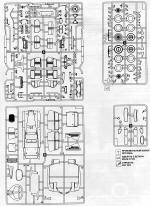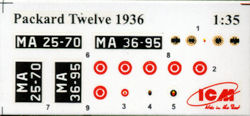
ICM 1/35 1936 Packard Twelve
| KIT #: | 35535 |
| PRICE: | $56.99 SRP |
| DECALS: | Three options |
| REVIEWER: | Scott Van Aken |
| NOTES: | New tool kit |

| HISTORY |
Entering into the 1930s, Packard attempted to beat the stock market crash and subsequent Great Depression by manufacturing ever more opulent and expensive cars than it had prior to October 1929. The Packard Twin Six (designed by Jesse G. Vincent) was introduced for 1932 and renamed the Packard Twelve for the remainder of its run (through 1939). For one year only, 1932, Packard tried fielding an upper-medium-priced car called the Light Eight.
As an independent automaker, Packard did not have the luxury of a larger corporate structure absorbing its losses, as Cadillac did with GM and Lincoln with Ford. However, Packard did have a better cash position than other independent luxury marques. Peerless fell under receivership in 1929 and ceased production in 1932. By 1938, Franklin, Marmon, Ruxton, Stearns-Knight, Stutz, Duesenberg, and Pierce-Arrow had all closed.
Packard also had one other advantage that some other luxury automakers did not: a single production line. By maintaining a single line and interchangeability between models, Packard was able to keep its costs down. Packard did not change cars as often as other manufacturers did at the time. Rather than introducing new models annually, Packard began using its own "Series" formula for differentiating its model changeovers in 1923. New model series did not debut on a strictly annual basis, with some series lasting nearly two years, and others lasting as short a time as seven months. In the long run, though, Packard did average approximately one new series per year. By 1930, Packard automobiles were considered part of its Seventh Series. By 1942, Packard was in its Twentieth Series. The "Thirteenth Series" was omitted.
To address the Depression, Packard started producing more affordable cars in the medium-price range. In 1935, it introduced its first sub-$1,000 car, the Packard 120. Car production more than tripled that year and doubled again in 1936. In order to produce the 120, Packard built and equipped an entirely separate factory. By 1936, Packard's labor force was divided nearly evenly between the high-priced "Senior" lines (Twelve, Super Eight, and Eight) and the medium-priced "Junior" models, although more than ten times more Juniors were produced than Seniors. This was because the 120 models were built using thoroughly modern mass production techniques, while the Senior Packards used a great deal more hand labor and traditional craftsmanship. The Junior models were very fine cars; they were just not in the same quality league as the Seniors. Although Packard most certainly could not have survived the Depression without the highly successful Junior models, the Juniors did have the effect of diminishing the Senior models' stellar and exclusive image among those few who could still afford an expensive luxury car. Adding insult to injury, the 120 models were more modern in basic design than the Senior models. For example, the 1935 Packard 120 featured independent front suspension and hydraulic brakes, both features that would not appear on the Senior Packards until 1937.
Extant 1936 Packard Twelves are selling in the $200,000 - $400,000 range.
| THE KIT |
 This
is probably one of the more impressive staff car kits that have been recently
produced by ICM. For decades, the Packard limousine was the car of choice by
presidents, kings and dictators alike. Their opulence for the time was well
known and having one was very much a status symbol.
This
is probably one of the more impressive staff car kits that have been recently
produced by ICM. For decades, the Packard limousine was the car of choice by
presidents, kings and dictators alike. Their opulence for the time was well
known and having one was very much a status symbol.
ICM's kit of this car falls very much in line with their other staff cars in that it has a full engine, in this case a flathead V-12, a fully detailed frame, tires that are made up of several 'slices' glued together to eliminate any mod seam issues, and a very detailed interior. Either by design or due to limitations in the molds, ICM's car bodies are not like the nearly one piece casting that one expects from Revell in the US, for instance. These are made up of segments that are glued together. In this case, the main body is split into left and right halves so there will be a full seam that the modeler will need to deal with. Each of the interior panels is separate and this includes the area that separates the VIP occupants from the more plebian driver. Like many car kits, the dash instruments are represented as decals, and that is fine with me as I am not good at detail painting dials.
The lower body section that includes the interior floor
and the front fenders and running boards are a single casting, which is a big
help. The rear fenders are added to this before the upper body is attached. Hood
side panels and doors are separate, but shown as being built in the closed
position. Those who wish to do some additional work could probably model them
open. The four doors are what we now call 'suicide
 doors' as
they are hinged at the back. Door handles and window winders are separate items.
The doors are provided as interior and exterior pieces, which makes painting
easier. The windows are then trapped between the halves.
doors' as
they are hinged at the back. Door handles and window winders are separate items.
The doors are provided as interior and exterior pieces, which makes painting
easier. The windows are then trapped between the halves.
Instructions are well drawn with color information in Model Master references. The small decal sheet is basically plates, instruments, and the logos that go in the center of the wheel hub. Black is the only color choice. This is supposed to be Stalin's cars so the 'Stalin and his gang' figure set is included as a bonus. For those wondering about the chrome and the whitewalls on the tires, those will need to be painted or you can use something like Bare Metal Foil.
| CONCLUSIONS |
Both fans of military vehicles (of a sort) and those who like antique cars from the 1930s will be delighted with this kit. It has a great deal of detail to please most and though not in a 'standard' car scale of 1/24 or 1/25, will still provide a rather large model that you will be pleased to display on your shelves.
| REFERENCES |
http://en.wikipedia.org/wiki/Packard
December 2012
Thanks to Squadron Products for the preview kit. You can find this one at your local shop or on-line retailer.
If you would like your product reviewed fairly and fairly quickly, please contact the editor or see other details in the Note to Contributors.